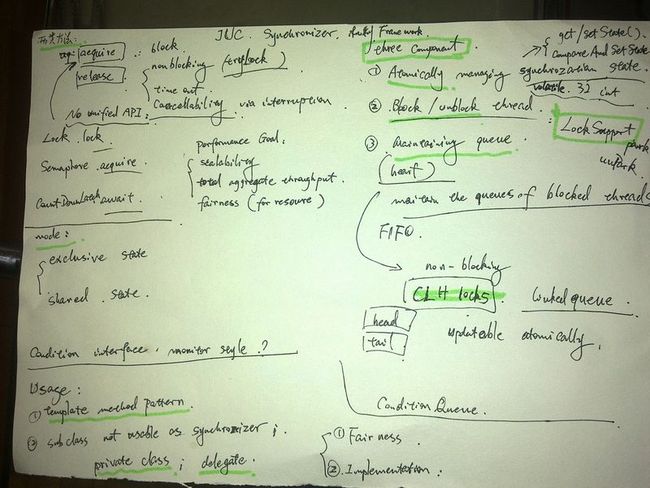java.util.concurrent 包下的 Synchronizer 框架
看完书 java concurrency in practice 当然是想找点啥好玩的东东玩玩。 当看到了Doug Lee 的论文 << The java.util.concurrent Synchronizer Framework >> 大呼来的太晚喔, 前段时间看那个ReentrantLock 的代码真的是痛苦啊,不过现在也不晚不是。 呵呵, 上菜:这个框架的核心是一个AbstractQueuedSynchronizer 类 (下面简称AQS) 它基本上的思路是:
- 采用Template Method Pattern. 它实现了non-contended 的synchronization 算法;
- 继承 它的Subclass 一般不直接作为Synchronzier, 而是作为私有的实现 被用来delegate. 比如 他举了个例子:
class Mutex implements Lock, java.io.Serializable {
// Our internal helper class
private static class Sync extends AbstractQueuedSynchronizer {
.....
}
// The sync object does all the hard work. We just forward to it.
private final Sync sync = new Sync();
public void lock() { sync.acquire(1); }
public boolean tryLock() { return sync.tryAcquire(1); }
public void unlock() { sync.release(1); }
public Condition newCondition() { return sync.newCondition(); }
public boolean isLocked() { return sync.isHeldExclusively(); }
public boolean hasQueuedThreads() { return sync.hasQueuedThreads(); }
public void lockInterruptibly() throws InterruptedException {
sync.acquireInterruptibly(1);
}
public boolean tryLock(long timeout, TimeUnit unit)
throws InterruptedException {
return sync.tryAcquireNanos(1, unit.toNanos(timeout));
}
}
在这个 AQS 类中 提供了 两大类方法
acquire 其中还包括 非阻塞的 tryAcquire; 带 time out 的;可以通过interruption 来cancellality 的。
release 相对简单点, 因为在调用release 方法的时候基本上暗含了个意思当前的线程是获得了锁的。
在JUC 包中没有为各种Synchronizer 类提供统一的API 比如 Lock.lock, Semaphore.acquire, CountDownLatch.await and FutureTask.get 都是映射到这个AQS 的 acquire 方法。
要实现一个Synchronizer 的基本思路非常直接的
acquire 操作
采用CAS 操作去更新同步状态 如果不成功 {
enqueue 当前线程
block 当前线程
}
dequeue 当前线程 if it was queued // 此时应该是当前线程被别的线程 release 来唤醒的。
release 操作 :
更新同步状态, 此时可以直接 set 而不通过 CAS。
假如 等待队列中还有线程 unblock one or more
要支持这些操作 需要 三类基本的组件:
1, Atomically managing synchronization state。 这个通过
private volatile int state;
在处理acquire 的时候基本是通过用CAS 实现的 compareAndSetState 来
2, Block /Unblock 线程 。 这个是通过 JUC 里面的一个封装类 LockSupport.park / unpark 来实现的。LockSupport 都deleget 到了 Unsafte 对应的方法
3, 维护 一个队列来存放 等待线程。 这个是通过一个 CLH queue 的变种。 它是一种linked queue 的通过 head 和tail 。
三个里面最复杂的就是这个 CLH queue 的维护了, queue 中节点被定义为 :
static final class Node {
volatile int waitStatus;
volatile Node prev;
volatile Node next;
volatile Thread thread;
Node nextWaiter;
final boolean isShared() {
return nextWaiter == SHARED;
}
final Node predecessor() throws NullPointerException {
Node p = prev;
if (p == null)
throw new NullPointerException();
else
return p;
}
Node() { // Used to establish initial head or SHARED marker
}
Node(Thread thread, Node mode) { // Used by addWaiter
this.nextWaiter = mode;
this.thread = thread;
}
Node(Thread thread, int waitStatus) { // Used by Condition
this.waitStatus = waitStatus;
this.thread = thread;
}
}
AQS 中定义了
private Node addWaiter(Node mode) {
Node node = new Node(Thread.currentThread(), mode);
// Try the fast path of enq; backup to full enq on failure
Node pred = tail;
if (pred != null) {
node.prev = pred;
if (compareAndSetTail(pred, node)) {
pred.next = node;
return node;
}
}
enq(node);
return node;
}
这个方法通常在 acquire 的时候如果 tryAcquire 失败就会将insert 一个 Node 到 tail 之后, 并且 node.prev 指向先前的 tail。 当然这个是在 compareAndSetTail(pred, node) 返回true 的时候比较简单, 否则就进入 enq(node) 方法 差不多也是这个逻辑 insert 一个 Node 到 tail 之后。
在 1.6.0_25 版本里面AQS 就没有在 release 的时候 通过唤醒等待队列里面head指向的线程, 然后然后该线程是在 方法里面继续resume, 基本上会
基本上来讲 有了 这个 AQS , 我们要想实现一个 Synchronizer 就比较简单了, 最简单的情况下 treAcquire , tryRelease 实现下。AQS 里面提供的需要继承的方法不是采用abstract 的方式 而是用抛出 notImplementedException的 方式, 如果像那些tryAcquireShared 之类的 在 exclusive 模式下根本就不会被调用到, 我们也就根本就不必override。 比如 先前我们所的那个 Mutex 我们只需要定义它的内部类 Sync
// Our internal helper class
private static class Sync extends AbstractQueuedSynchronizer {
// Report whether in locked state
protected boolean isHeldExclusively() {
return getState() == 1;
}
// Acquire the lock if state is zero
public boolean tryAcquire(int acquires) {
assert acquires == 1; // Otherwise unused
if (compareAndSetState(0, 1)) {
setExclusiveOwnerThread(Thread.currentThread());
return true;
}
return false;
}
// Release the lock by setting state to zero
protected boolean tryRelease(int releases) {
assert releases == 1; // Otherwise unused
if (getState() == 0) throw new IllegalMonitorStateException();
setExclusiveOwnerThread(null);
setState(0);
return true;
}
// Provide a Condition
Condition newCondition() { return new ConditionObject(); }
}
这个框架是非常精巧的, 还有很多地方比如那个 ConditionObject 里面涉及到另外一个单独的condition queue。只有再慢慢的啃了。
另外贴一张本人手工画的图,非常潦草多包涵了。
